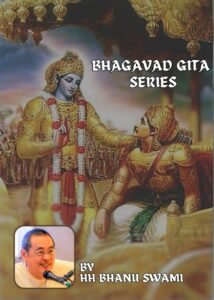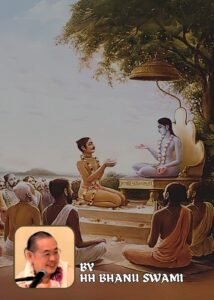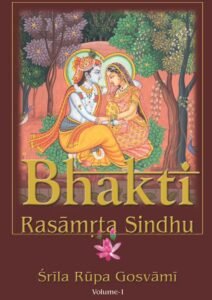Srimad Bhagavad Gita -1 by HH Bhanu Swami Maharaj on Dec 11, 2024 @ ISKCON JAPAN
In the Nectar of Devotion and the 64 Angas of Bhakti, there are four types of seva we can do. We can serve the devotees, we can serve Tulsi Devi and we can serve the Dham, and we can serve Bhagavatam. So, just as we serve devotees or the Supreme Lord, we can also serve Bhagavatam.
So our Acharyas put most emphasis on Bhagavatam. And that is because it has detailed descriptions of Krishna’s pastimes. However, Bhagavad Gita is well known among all people of India.
People may not know about Bhagavatam, but at least they’ve heard the word Bhagavad Gita, and hopefully they know a few verses from it. And all the famous Acharyas, including Shankaracharya, have written commentaries on Bhagavad Gita. And in fact, a Sampradaya should be a Sampradaya if it has a commentary on Bhagavad Gita.
However, we see that our Acharyas didn’t write any commentaries until a few hundred years later. Vishwanatha and then Baladeva Vidyabhushan wrote commentary on Bhagavad Gita, but that was a few hundred years after Lord Caitanya.
So Bhagavad Gita comes within the Mahabharata. And Mahabharata is accepted as an authorized scripture. Mahabharata has many, many statements, many, many stories, many, many philosophies, but the essence is in Bhagavad Gita. So we can accept it as guidance for our spiritual life.
Originally, the Vedas were the most authorized scripture, but they’re very huge and also difficult to understand. So Vedavyasa, thinking of the people of Kali Yuga, wrote Mahabharata for the common people, easier to understand. Within that, we have the Bhagavad Gita, which is a summary of all the Vedic knowledge.
In the modern world however, even reading Bhagavad Gita is too complicated. And even if we have commentaries, even the commentaries cannot be understood by the people. Nevertheless, we should try to make the Bhagavad Gita a practical work for people. It’s not just a work of philosophy. So there’s this one verse here, not even written by Acharyas, I think it’s written by Shankaracharya actually, it’s in the Gita Mahatmya, which summarizes very nicely the practical nature of the Bhagavad Gita.
So what this verse says is, there’s one scripture, Bhagavad Gita. We don’t have to go through all the Vedas, Upanishads, etc. We don’t have to worship Devatas, we don’t even have to worship other forms of the Lord, just worship Krishna. So what is our action? We serve Krishna. How do we serve Him? So we chant His name. So this is a very good summary of practical use of Bhagavad Gita.
When we start reading the Bhagavad Gita in the first chapter, we have a whole long list of people fighting in. And we may wonder why fighting is spiritual? However, it is through this battle, or the beginning of the battle, that we get this conversation between Krishna and Arjuna. The Battle of Kurukshetra is a big conflict, but we have conflicts all the time.
And for most people, conflicts are not very enjoyable. If you’re a Kshatriya may be its enjoyable but for other people ‘NO’. And of course, in big battles etc., a lot of innocent people get killed, so it’s not a good affair. In these conflicts, we have a clash of different ideas, different philosophies, different religions.
And if a person is intelligent, then he will ask questions. What is the truth? Who is right and who is wrong? What is the best action to take? Should I fight or not fight? What is the goal we’re trying to achieve? So when we do have conflicts and when all these questions arise, hopefully we can get a solution, we can get an answer to our questions. Yeah, okay, so, of course, to bring about a solution, it’s not just an idea, we actually have to change.
We have to change who we think we are. We have to change how we see the worlds. We may be seeing it one way; we have to see it in a different way.
So in Bhagavad Gita, Krishna presents some principles, and we have to change the way we look at everything to accept these principles. Starting in the second chapter, Krishna begins to talk about the mind. And the mind is very powerful, it determines our life. The way we think, will determine our future. So not only will it determine the future of this life, it will also determine your next life.
So if we want to change our life, we have to change the way we think. So the mind is so powerful that it can even form your next body. Bharata thought of a deer when he was dying, he became a deer. He got an actual physical body of a deer because he thought of a deer. So, in order to control and determine our future, we have to control the mind.
So Krishna says, one must deliver himself with the help of the mind, not degrade himself. The mind is a friend of the conditioned soul and is an enemy as well. Even in the Western world nowadays, they often talk about how if you focus on something, a goal, you can attain it. The problem is, we cannot focus our mind on that goal. So constantly you have to concentrate on that goal. Constantly you have to control the mind.
We know that meditation means to concentrate on one object and don’t think of anything else. So if you think of Krishna enough, you attain Krishna. The example is given in the Bhagavatam. Even Kamsa and Sisupala, though they hated the Lord, they hated Him so intensely that they meditated on Him intensely, and so they attained Him. So, if we concentrate our mind on certain things, this will lead us to do actions also to attain those things. So in terms of bhakti, then we think of Krishna, meditate on Krishna, and we serve Krishna.
This becomes very powerful if we add feelings, that is bhakti to it. Of course, Kamsa and Sisupala concentrated with hatred, but as devotees, we like to concentrate on Krishna with bhakti. This is a very powerful way of achieving our goal.
So along with this idea that we have the mind and whatever, and we do actions, we have a sense of responsibility. We can concentrate on our goals, and we can do actions, but we have to be careful! how we do those actions. So we can think of the actions in terms of what we get from the action, but it’s more complicated because every act we do affects other living entities. And the more that we get negative effects on other living entities, that is violence to other living entities by our action, this will block achieving our goal.
So we have to learn to be responsible for the effects of our action. This means we have to choose very carefully what we do. So to help us become responsible, we have the law of karma. If my actions produce suffering for others, I will get equal suffering on myself. Nobody likes suffering, but this is what we’ll get, so this will interfere with our goals. If we do actions that benefit others, then we get benefit for ourselves. So this law is inescapable. We cannot hide from this law. We cannot bribe anybody. Everything is witnessed, and we will get the result. So we have to be very alert to see the effect of our actions.
There’s another shift we have to make, presented in the Bhagavad Gita, and that is, the mind is useful for not only focusing on goals, but setting goals, we can choose what we want to achieve. So by using the mind, we can choose a proper goal, and using the mind, we can attain the goal. However, we should not choose foolish goals. We should use our intelligence. If we don’t have enough intelligence, we take the guidance of scripture. So the scripture will help us choose the proper goal.
If we don’t have a goal, we don’t achieve anything. So the clearer we can define the goal, the more likely we can achieve the goal. Of course, in the modern world, so many goals are forced upon us, we don’t get much choice. However, that’s also an illusion, nothing is forced on us, we still have choice.
The Bhagavad Gita tells us all these material goals are impermanent. You cannot take them with you when you die. So we get job, family, society, friends, money, success, fame, these are the usual goals that people have. You can attain them, but they’re all temporary. So Bhagavad Gita says, this material world is a place of suffering, and it is impermanent. So the mind is useful if we set the goal, but we have to have a nice goal, a proper goal. So the big shift we have to make is to understand the real goal is not in this material world. And we should realize we’re not the body. This is the fundamental principle in the Bhagavad Gita. And this is the basis of spiritual life.
So this means that we realize I’m not the body, I am Atma. So the Atma is a particle of consciousness. It is eternal, and though the body may die, the Atma does not die. It goes to another body. It looks like a very logical explanation, but surprisingly, most people aren’t aware of it. So most people are concentrating on their body, which is made out of matter. The matter is unconscious, it is lifeless. It’s temporary. It’s subject to decay. And whatever is material, we can lose it. The body gets sick, gets old, and it dies. So if we identify with our body, we think we’re our body, and we get attached to material things, whatever our goal is, it’s going to produce suffering.
So the step we have to make is to realize that we are not the body, we are Atma. Atma is life. Atma is conscious. The Atma knows things. Atma performs actions. And the Atma experiences joy. Atma is eternal. It’s without change or death. Atma is beyond time and space.
So our spiritual goal should be to free the Atma from this material body. If we do that, then we have no fear of death, no fear of the future. We’re not attached to material acquisition, to reputation, fame, etc. We’re free from desire and hatred. We’re free from thinking of friend and enemy. So we can get peaceful existence.
So this is one step in spiritual life. If a person attains this, they may think this is the final step. This is introduced in chapter two of Bhagavad Gita, but it’s not the final step, it’s only the first step. So the big shift after understanding Atma is to realize the Supreme Atma, the Supreme Lord. So Atma is not the body, etc. But we get out of the body, not only Atma is there, we have Supreme Lord.
So though we are different from the material body, still we can get the assistance and guidance and protection of the Supreme Lord. So Atma, of course, it cannot be killed, etc., but still, the Atma has a shelter, a protector, the Supreme Lord. And this gives great comfort to the individual Atma. Supreme Lord acts as a great friend. Everybody wants nice relationships. We can establish the best relationship with the Supreme Lord.
Everybody wants love. The supreme perfect object of love is Krishna. He has a beauty which is perfect and eternal. And not only He has beauty, He is full of all wonderful qualities. So we can establish a relationship with the Supreme Lord, and we get perfect response, perfect reciprocation. And we are not alone with the Lord. There’s not only one person with the Lord, there are so many other Jivas with the Lord, so we have a perfect community in the spiritual world.
So the highest goal, we are supposed to set goals, so the highest goal is not just to realize Atma, but to realize Atma’s relationship with the Supreme Atma, the Supreme Lord. So, though Krishna praises Jnana Yoga in Bhagavad Gita, He says better than Jnana Yoga or Ashtanga Yoga is Bhakti Yoga. It’s in Bhakti Yoga that we get realization not only of Atma, but of Supreme Lord. If we practice Jnana or Yoga, we can realize Atma, but not Supreme Lord. If we just do Karma Yoga, we can’t even realize Atma.
So Krishna says we do Bhakti Yoga, and in this way we establish this loving relationship with Supreme Lord. And what is the result? We experience the highest bliss. So the goal of the individual is to be happy, but we get eternal happiness and the highest happiness by establishing our relationship with Supreme Lord.
And thus at the end of Bhagavad Gita, Krishna tells us, give up all the processes, just do Bhakti Yoga. So, in the process of Bhakti Yoga, we can also use the mind. We can use the mind to choose our goal and focus on the goal. Although the mind is material, it’s very powerful. So we can utilize the mind for our spiritual advancement.
So mantra means to use the mind for spiritual development, deliverance. So using the mantra is part of Bhakti Yoga. There are many mantras, but the simplest mantra is name of Krishna. At the beginning of the presentation, we had this quotation, and what is the mantra? Mantra is name of Krishna. So it is very simple, but it is most powerful. So, if we can’t read the whole Bhagavad Gita or understand what it means, at least understand the last instruction, give up all other methods and simply surrender unto Krishna.
So how do we surrender? We chant the mantra. We utilize the mind, and through that we chant the mantra, and we get eternal bliss. So at least that much knowledge we should get out of the Bhagavad Gita.
Okay, Hare Krishna.
Q&A
1) What is the difference between the Vedas and the Bhagavad Gita?
HH Bhanu Swami Maharaj: Yeah, so the Vedas are, there’s four Vedas. They’re written in a difficult language, and they’re difficult to understand, and they’re very big [Laughs] and not all people are qualified to study or to recite the Vedas. So Vedavyasa wrote Mahabharata to contain the knowledge of the Vedas in a simpler form. And it’s open for all people. Everybody can study, everybody can recite Bhagavad Gita and Mahabharata.
So the Bhagavad Gita contains the essential knowledge of the Vedas in a condensed form. And it also clearly gives the final conclusion of the Vedas. But more easily available to common people.
Devotee: Thank you very much. Hare Krishna.
HH Bhanu Swami Maharaj: What is that?
Devotee: It was easy to understand. Thank you very much.
HH Bhanu Swami Maharaj: Okay, I think I have to go. I’ve got a meeting right now. Hare Krishna!
Devotee: Thank you very much.
Devotees: Srimad Bhagavad Gita Ki.. Jai ! Srila Prabhupad Ki.. Jai !! HH Bhanu Swami Maharaj Ki.. Jai !!


